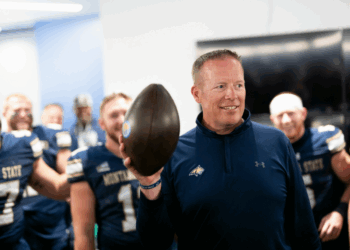How the Father of Modern-Day Fly Fishing saved himself
EBS STAFF
It was January of 1955 when Joe Brooks first cast into the rich waters of Argentina’s Tierra del Fuego, astonishing the native onlookers. The archipelago, on South America’s southernmost tip, is famous for gusting sea winds so powerful that trees warp into permanently mangled, unnatural forms; casting a fly with any semblance of precision was unheard of, yet Brooks rolled out cast after cast on target. He then doubled down on the spectacle, landing a monster sea-run brown trout, and proceeded with the unthinkable—releasing it, alive, back into the water.
“His casting and his ability to fight the winds blew these Argentinians away,” said Joseph Brooks, Joe Brooks’ great nephew. “They fished with a ‘catch it, kill it’ belief, so for him to release this impressive of a fish was inconceivable.”
Joe Brooks was a prolific American angler, a pioneer of modern-day fly fishing, who pushed the envelope on what was thought possible with a fly rod, untethering the sport from decades of worn-out convention. His ascension was a lifelong one marked by passion for adventure and respect for game fish and the environs they inhabited, but also by a generosity of spirit that influenced anyone who encountered it.
Brooks mentored the likes of Bing Crosby, Jack Nicklaus and Red Sox great Ted Williams, as well as fly fishing legends Lefty Kreh and Stu Apte, the latter dubbing him “a second father”; he played a pivotal role in the founding of The Brotherhood of the Jungle Cock, an organization dedicated to bringing the joys of fishing to young men with an emphasis on promoting conservation. Brooks also wrote about his experiences, publishing missives in simple, charming prose for the likes of Field and Stream, The Baltimore Sun and Outdoor Life—his ability to communicate fly fishing and its transcendental splendors led to written works still considered leading gospel by the sport’s patrons.

“He’s just one of those people that had that charisma, a wonderful and generous man,” said John Bailey, proprietor and son of the eponymous founder of Dan Bailey’s Fly Shop in Livingston, Montana. “He just impacted fishing so deeply, and in so many ways.”
Yet, in true hero’s fashion, Brooks’ road to legend revealed an imperfect character. By 1930, many thought Brooks was dead, and like so many marred souls, he’d once shown tremendous promise. A natural-born athlete, at just 17 years old Brooks was a top prospect for the Baltimore Orioles. He’d been admitted into Princeton University (albeit briefly, getting the boot after just one semester), and had married into the Dickey clan, one of the most prestigious and wealthy families in the Mid-Atlantic.
Despite these gifts of character and aptitude, his charmed life unraveled into seemingly irreversible turmoil. Brooks abused his newfound social status gained in marriage, raging through the roaring ’20s with little acknowledgement of his mounting troubles with alcoholism and a penchant for brawling. Brooks and the distinguished debutante Arline Dickey divorced four years after their marriage, and as the glimmering prosperity of the decade was replaced by the Great Depression of the 1930s, so too did the sheen disappear from Brooks—he vanished, without a trace, into the sadness that blanched the spirit of a once-proud American people.
Lore surrounds those mysterious years. Brooks is rumored to have played semi-pro football in California. Another tale has him assisting an elderly man with a trapping outfit in remote Michigan. Some claim he was among the earliest competitors in a precursor to the multibillion faux-wrestling industry, grappling in the Lumberjack Circuit of Minnesota. He would speak little of that time. What is known is that Brooks eventually landed in Toronto’s Wood Sanatorium, a secretive and experimental facility dedicated to treating alcoholism as a disease and not a moral defect, among the first of its kind.
Released for a second chance at life, a sober 36-year-old Brooks chased respite by fishing the eddies of Maryland’s streams and rivers, a gentler pastime of a younger self. It was a rekindled passion that transformed Brooks from a pariah into a celebrated god of fly fishing, definitively securing him a throne in sport’s pantheon, and allowed a once-dormant kindness to blossom.
“I think my life was altered by knowing Joe Brooks, absolutely,” said Stu Apte, a fellow fly-fishing hall of famer and renowned author. “Spending time with Joe, trying to emulate him, made me a better person.”
***
Those who fly fish know the sport is imbued with a tacit mysticism and reverence for wildlife other sects of fishing struggle to achieve. Fly fishing requires the angler to imitate nature with such precision as to join it. There is no room for compromise, presentation must be near perfect and, when refraining from over-tackling with heavy synthetics, a hard credo of Brooks’, the engagement is one of fairness and respect; no contest between man and beast is so undecided from first strike.
“When you’re fishing with 20-plus-pound test [fishing line], unless you completely fatigue there’s just no way you can lose that fight. The fish will never break the line,” said Brooks’ great nephew Joseph, who together with brother Michael produced the 2018 documentary, Finding Joe Brooks. “But when you’re fly fishing, there’s this sense that either side could win. It’s a fair contest, and Joe valued that.”
Joe Brooks’ regard for game fish extended beyond the fight. A true sportsman of well-made integrity, Brooks allowed his opponent to fight again in an act known as “catch and release,” a measure of grace he passed unto his Argentinian companions under sheets of rain and howling wind in 1955. Some could argue his greatest contributions were realized in far-flung nations, fishing not only fresh water but also brackish and salt, and landing record-sized species previously thought impossible to catch on a fly. Yet it’s that ethos, popularizing the release of what was landed, that made Brooks remarkable.
“I think it speaks to his character, one-hundred percent a reflection of the regard he held the resource in,” said Flip Pallot, a student of Brooks’ best-known disciple, fly-fishing legend Lefty Kreh.
Brooks’ understanding of what it meant to fight for life was intimate, and so the concept of catch and release was tailor-made. Perhaps Brooks saw himself in conquered fish, summoning bitter memories of a time spent floundering in the throes of a former self. Brooks understood even those with nothing left to give, in a state of complete and total vulnerability, should be honored with a second chance.
Joe Brooks spent the late summers and autumns of his final years in Montana’s Paradise Valley, fishing the untamed rivers lined with quaking aspens and cottonwoods. He would die there in September of 1972, mere weeks after telling friends that when the time was right he wanted to “die with a fly rod in hand, facing upstream.” Not many get to choose the way they perish, as Brooks did. And he spent his last hours releasing trout and giving them the chance to fight again..
This story was originally published in the summer 2019 edition of Mountain Outlaw magazine.














